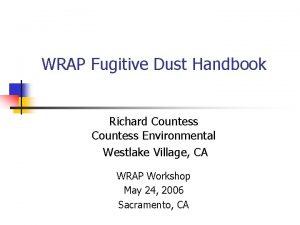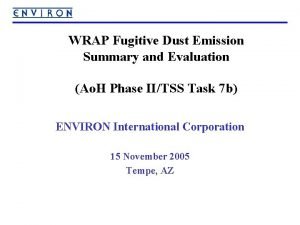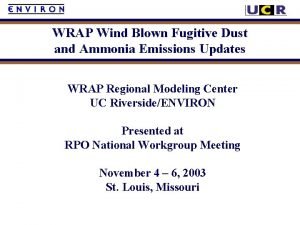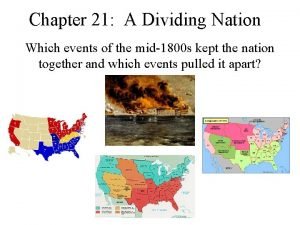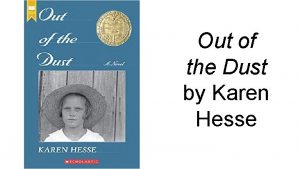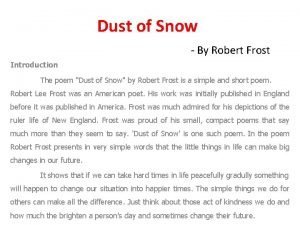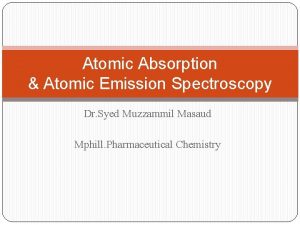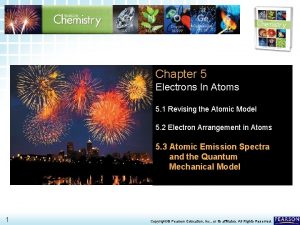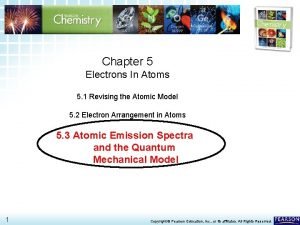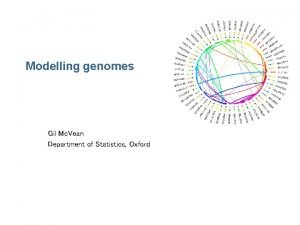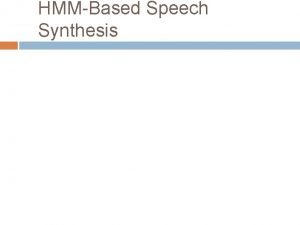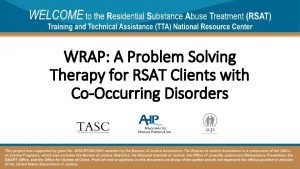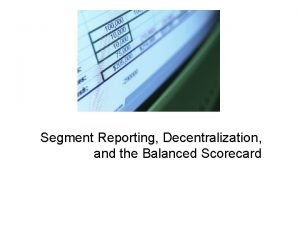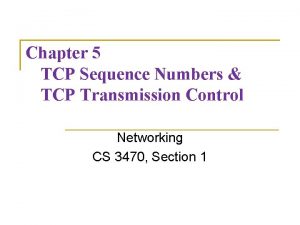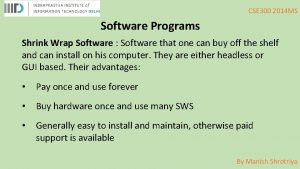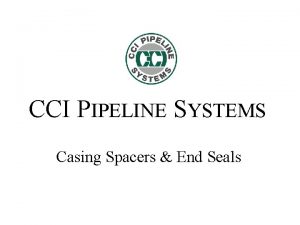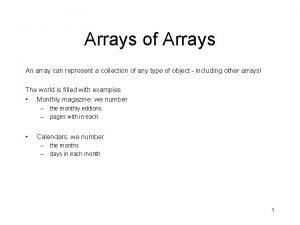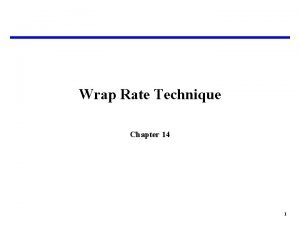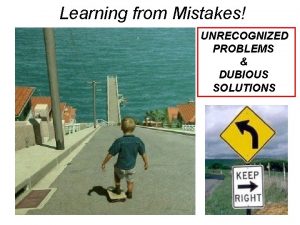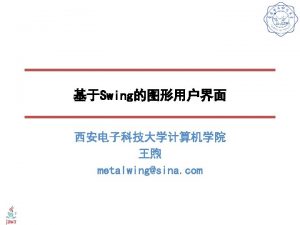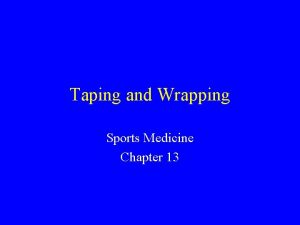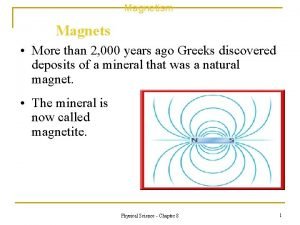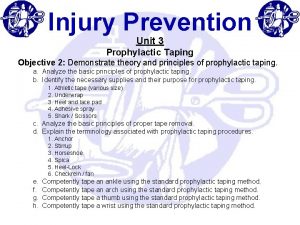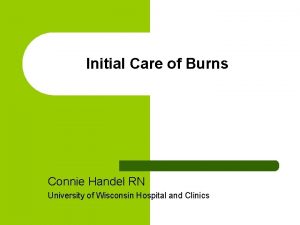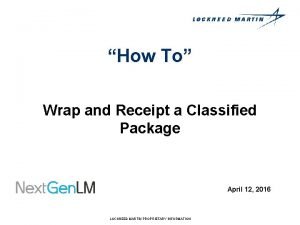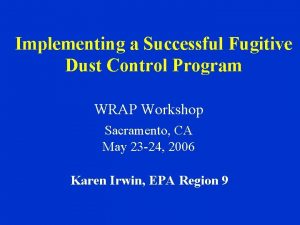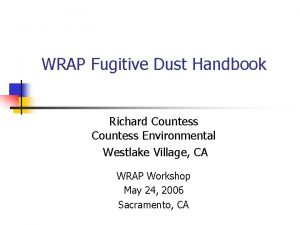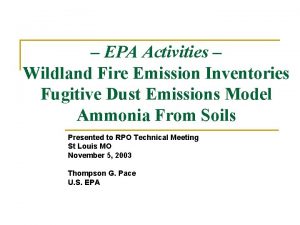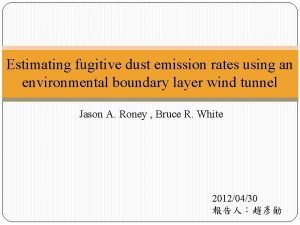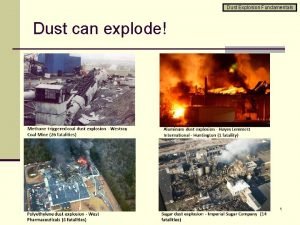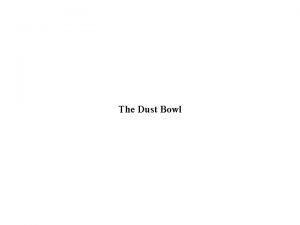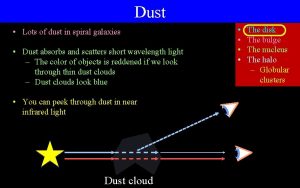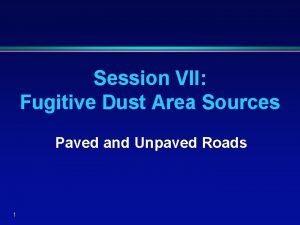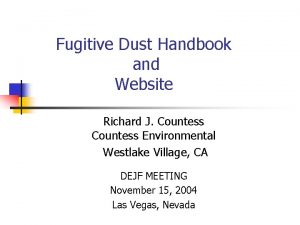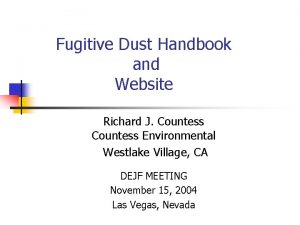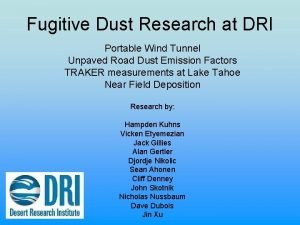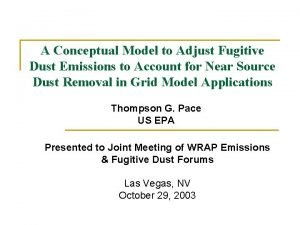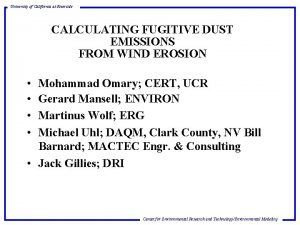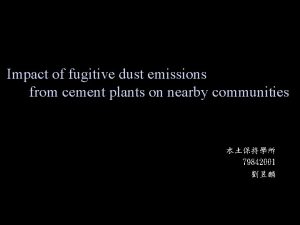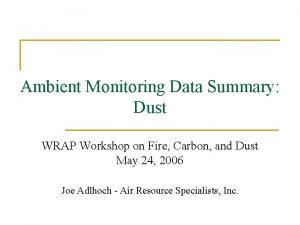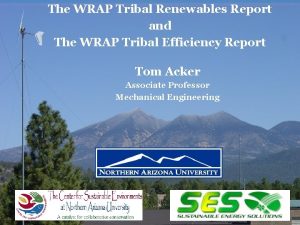WRAP Fugitive Dust Emission Summary and Evaluation Ao





















































- Slides: 53

WRAP Fugitive Dust Emission Summary and Evaluation (Ao. H Phase II/TSS Task 7 b) ENVIRON International Corporation 15 November 2005 Tempe, AZ

Outline • • Project Objectives Fugitive Dust Source Categories Emission Estimation Methodologies 2002 Annual County-level Summaries 2002 Annual Gridded Summaries PM 2. 5/PM 10 Ratios Next Steps

Project Objectives • Summarize all fugitive dust emission sources • Evaluate dust emissions for reasonableness and consistency – Review estimation methodologies (AP-42, State/local studies, regional models, etc. . ) – Review fine fraction (PM 10/PM 2. 5) • Develop SCC-level summaries: – County-level – Model-ready, gridded • Develop summaries by geographic region • Consider 2002 and 2018 EIs

Fugitive Dust Source Categories • Agricultural Dust – Harvesting – Tilling – Transport – Feedlots • Construction Dust – Mining/Quarrying – Road Construction – Residential – Industrial/Commercial/Institutional • Road Dust – Paved – Unpaved • Windblown Dust

Estimation Methodologies • Agricultural Tilling – 2002 NEI grown from 1998 • Growth factors vary by tilling type (0. 77 – 1. 16) – Activity is acres tilled by type and crop (from CTIC) – EF = 4. 8*k*s 0. 6*p • k=particle size multiplier (PM 10 = 0. 21; PM 2. 5 = 0. 042) • S = silt content (USDA data; varies by soil type) • P = # of passes/tilling per year (varies by crop) – E = EF * A

Estimation Methodologies • Construction – Residential – Emissions are function of acres disturbed and volume of soil excavated (varies by type of structure) – Activity data (housing starts by structure type) from Dept. of Commerce – Emission factors vary by structure type and duration of construction (0. 011 tons PM 10/acre-month – 0. 11 tons PM 10/acre-month) – Adjustments applied for soil moisture, silt content and control efficiency

Estimation Methodologies • Construction – Non-Residential – Emissions are function of acres disturbed – Activity data (value of construction in $MM, allocated from national to county based on employment statistics) from Dept. of Commerce – Number of acres disturbed estimated as 1. 55 acres/$MM applied to county-level construction valuation data – Emission factor = 0. 19 tons/acre/month (assumed 11 month construction duration) – Adjustments applied for soil moisture, silt content and control efficiency

Estimation Methodologies • Road Construction – Emissions are function of acres disturbed; developed from – – – FHWA data State-level new miles of road construction from 2002 FHWA state expenditure data by road type Converted to $/mile using NCDOT conversion data; converted to acres disturbed/mile by road type State data allocated to county based on residential building starts Emission factor = 0. 42 tons/acre/month; assumed 12 month duration Adjustments applied for soil moisture, silt content and control efficiency

Estimation Methodologies • Paved Road Dust – Uncontrolled emissions estimated at state level by roadway class and – – month Calculated as State/Roadway class VMT * TAF * EF Spatially allocated to counties based using VMT surrogate Controls applied to Non-Attainment counties EF = [k*(s. L/2)0. 65 *(W/3)1. 5 -C]*[1 -P/(4*N)] • • • k= particle size multiplier (PM 10 = 7. 3; PM 2. 5 = 1. 8) s. L = silt loading W= avg. vehicle weight C = EF for 1980 fleet N= # days in month P= # days with precip. > 0. 01 in – Annual VMT data from FHWA Statistics – County emissions = State Emissions * (VMTcounty/VMTState) – Assumed control measure: Vacuum sweeping twice/month; 79% control efficiency. ; Rule penetration varies by roadway class and NA status; 100% Rule Effectiveness

Estimation Methodologies • Unpaved Road Dust – Uncontrolled emissions estimated at state level by roadway class and – – month Calculated as State/Roadway class VMT * TAF * EF Spatially allocated to counties based using 1990 rural population surrogate Controls applied to Non-Attainment counties EF = [k*(s/12)a *(SPD/30)b]/(M/0. 5)c-C • • • k= particle size multiplier (PM 10 = 0. 27; PM 2. 5 = 1. 8) s = silt loading SPD = mean vehicle speed M = moisture content C = EF for 1980 fleet a, b, c = empirical constants – EF adjusted for precip: Efcorr= EF * [(D-p)/D)] • D = # days in month • P = # days with precip > 0. 01 in.

Estimation Methodologies • Unpaved Road Dust (continued) – Annual VMT data from FHWA Statistics • Separate estimates for county and non-county roadways • County-maintained VMT by road type and ADTV • State/Federal-maintained VMT by arterial classification; county-maintained VMT used – Annual VMT estimates allocated seasonally and monthly – County emissions = State Emissions * (Rural Pop. county/Rural Pop. State) – Assumed control measures vary by Non-Attainment classification (paving and/or chemical stabilization). Control efficiency, rule penetration and rule effectiveness vary

Estimation Methodologies • Windblown Dust – WRAP Phase II WB Dust Model – 2000 Landuse/Landcover data • BELD 3 county-level crop percentages – STATSGO Soils data – 2002 MM 5 Meteorology (36 - and 12 -km) – Latest Transport Fractions (EPA, 2005) – PMC/PMF = 0. 9/0. 1

RPO-Specific Revisions/Enhancements • WRAP – Road Dust – Developed by ENVIRON. • CA emissions interpolated from previous EI development • Unpaved VMT based on NET 96 updated with state survey results • VMT data adjusted based on Clark Co. ADTV revisions factor • Silt loading from IL State Water Survey • Precipitation data from NCDC • Applicable control measures from State survey results – Agricultural Dust - Developed by ERG based on 2002 draft NEI (gap-filled by EPA/Pechan). Additional state submissions included as part of WRAP EI Update process. – Construction Dust - 2002 NEI estimates submitted by States

RPO-Specific Revisions/Enhancements • CENRAP – Agricultural Dust – Developed by STI based on local activity data, county- level silt loading and tilling practices, monthly allocation by state. Includes some livestock feedlot dust emissions – Construction and Road Dust from 2002 NEI • VISTAS – 2002 NEI State submissions for all sources • MWRPO – Agricultural and Construction Dust (IL & IN only) - Based on 2002 State CERR data – Road Dust – WRAP 2002 inventory data – All Fugitive dust emissions dramatically reduce through application of transport fractions (90%-97%). Based on monitoring data analyzed by LADCO • MANE-VU – 2002 NEI for all dust sources

2002 Fugitive Dust Inventory

2002 Fugitive Dust Inventory

2002 Fugitive Dust Inventory

2002 Fugitive Dust Inventory

2002 Fugitive Dust Inventory

2002 Fugitive Dust Inventory

2002 Fugitive Dust Inventory

2002 Fugitive Dust Inventory

2002 Fugitive Dust Inventory

2002 Fugitive Dust Inventory

2002 Fugitive Dust Inventory

2002 Fugitive Dust Inventory

2002 Fugitive Dust Inventory

2002 Fugitive Dust Inventory

2002 Fugitive Dust Inventory

2002 Fugitive Dust Inventory

2002 Fugitive Dust Inventory

2002 Fugitive Dust Inventory

2002 Fugitive Dust Inventory


2002 Fugitive Dust Inventory





Spatial Distribution of Fugitive Dust Emissions

Spatial Distribution of Fugitive Dust Emissions

Spatial Distribution of Fugitive Dust Emissions

Spatial Distribution of Fugitive Dust Emissions

Spatial Distribution of Fugitive Dust Emissions

Spatial Distribution of Fugitive Dust Emissions

Proposed Revisions to Fine Fraction Ratios Used for AP-42 Fugitive Dust Emission Factors Source Category Paved Roads Unpaved Roads Construction & Demolition Aggregate Handling/Storage Piles Industrial Wind Erosion Agricultural Tilling AP-42 Section 13. 2. 1 13. 2. 2 PM 2. 5/PM 10 Ratio Current Proposed 0. 25 0. 15 0. 10 -- 0. 208 0. 10 13. 2. 4 0. 314 0. 10 (traffic) 0. 15 (transfer) 13. 2. 5 0. 40 0. 15 -- 0. 222 0. 20

PM 2. 5/PM 10 Ratios

PM 2. 5/PM 10 Ratios

PM 2. 5/PM 10 Ratios

PM 2. 5/PM 10 Ratios

PM 2. 5/PM 10 Ratios from Gridded Data

PM 2. 5/PM 10 Ratios from Gridded Data

Next Steps • Revise PM 2. 5/PM 10 fractions (? ? ) • Evaluate/Summarize Revisions for Base 02 a • Evaluate 2018 inventory • Prepare Technical Memorandum
 Wrap fugitive dust handbook
Wrap fugitive dust handbook Wrap fugitive dust handbook
Wrap fugitive dust handbook Wrap fugitive dust handbook
Wrap fugitive dust handbook Fugitive slave act summary
Fugitive slave act summary Chapter 21: a dividing nation answer key
Chapter 21: a dividing nation answer key Fugitive slave act significance
Fugitive slave act significance Fugitive slave act
Fugitive slave act Out of the dust summary
Out of the dust summary Out of the dust characters
Out of the dust characters What does dust of snow
What does dust of snow Sin 22 5
Sin 22 5 Difference between absorption and emission spectrum
Difference between absorption and emission spectrum Atomic emission spectra and the quantum mechanical model
Atomic emission spectra and the quantum mechanical model Atomic emmision spectrum
Atomic emmision spectrum Emission and absorption spectra grade 12
Emission and absorption spectra grade 12 Tga vean
Tga vean Synthesis
Synthesis Rp tsade
Rp tsade Used to lay out any noncircular curve
Used to lay out any noncircular curve How to wrap a wrist with an ace bandage
How to wrap a wrist with an ace bandage Wrap crisis plan examples
Wrap crisis plan examples Mwrap contractor portal
Mwrap contractor portal Segment reporting and decentralization
Segment reporting and decentralization Floor director hand signals
Floor director hand signals Karn partridge algorithm
Karn partridge algorithm In an oxidation-reduction reaction milady
In an oxidation-reduction reaction milady Body paragraphs definition
Body paragraphs definition Wrap assessment
Wrap assessment Healthy lifestyle wrap up lecture
Healthy lifestyle wrap up lecture Daily maintenance plan wrap
Daily maintenance plan wrap Css wrap-flow
Css wrap-flow Shrink wrap software
Shrink wrap software Chapter 27 nail tips and wraps review questions
Chapter 27 nail tips and wraps review questions Cci pipeline systems
Cci pipeline systems Vuzix wrap 280
Vuzix wrap 280 Magic square wrap around array java
Magic square wrap around array java Rmc com wrap
Rmc com wrap What is a wrap rate
What is a wrap rate Present perfect tense play
Present perfect tense play Wrap uk
Wrap uk Skynet 6 service delivery wrap
Skynet 6 service delivery wrap Shrink wrap
Shrink wrap Swing import
Swing import Define wrap up
Define wrap up Wrist taping athletic training
Wrist taping athletic training Dcap bls tic
Dcap bls tic Chemical services cosmetology
Chemical services cosmetology A single wire wrap into a cylindrical wire coil is called
A single wire wrap into a cylindrical wire coil is called Wrap irregular verb
Wrap irregular verb Asset protection for contractors
Asset protection for contractors Check rein tape
Check rein tape Plastic wrap
Plastic wrap Wrap ah recept
Wrap ah recept Environmental tip
Environmental tip
